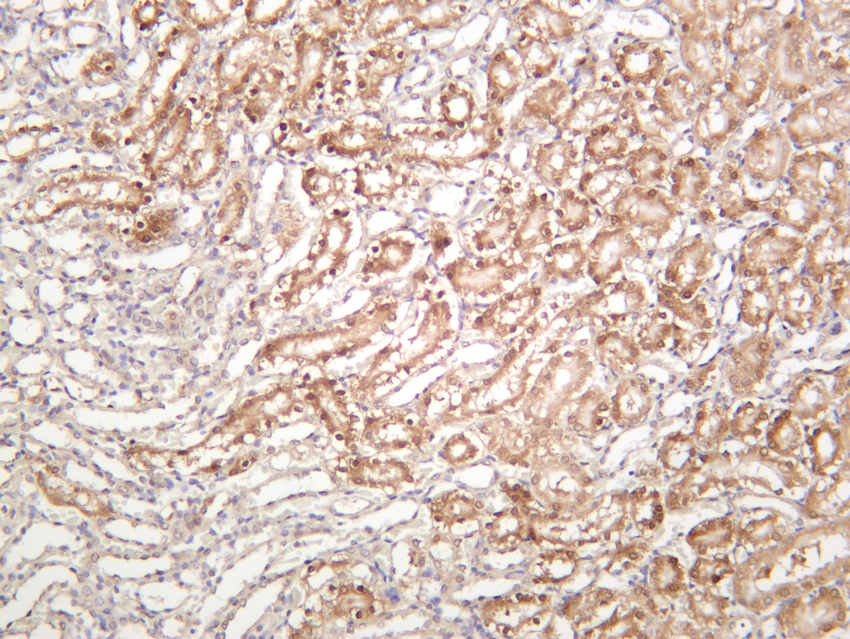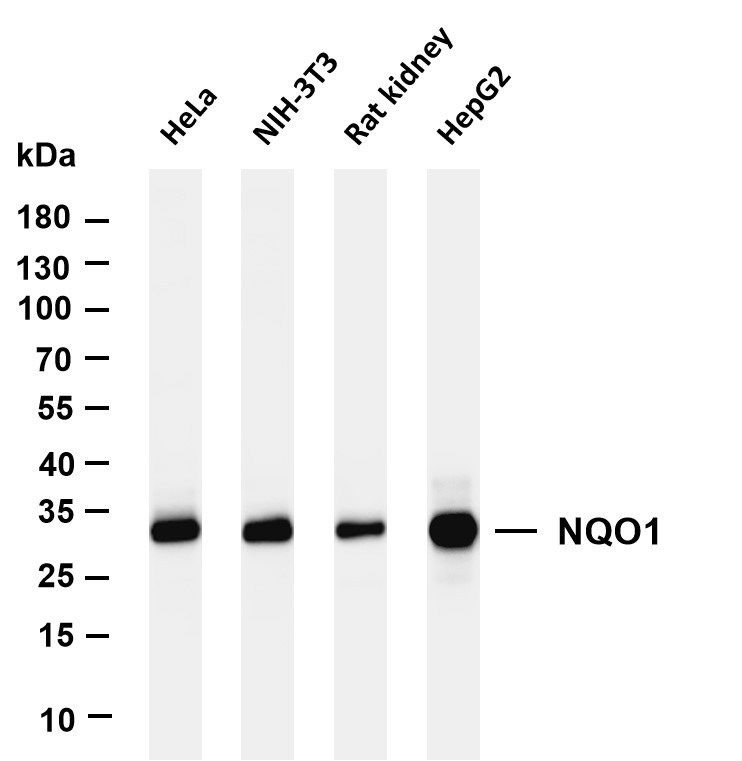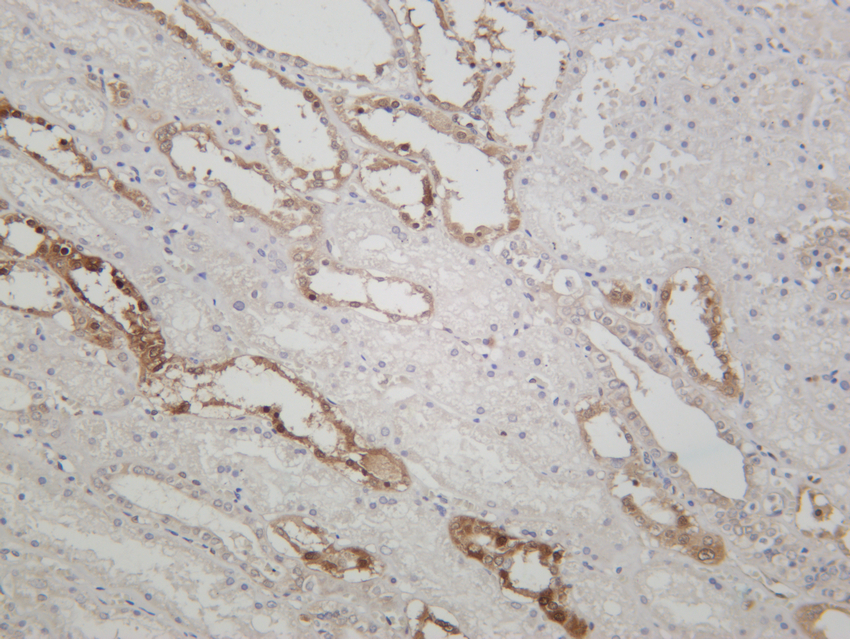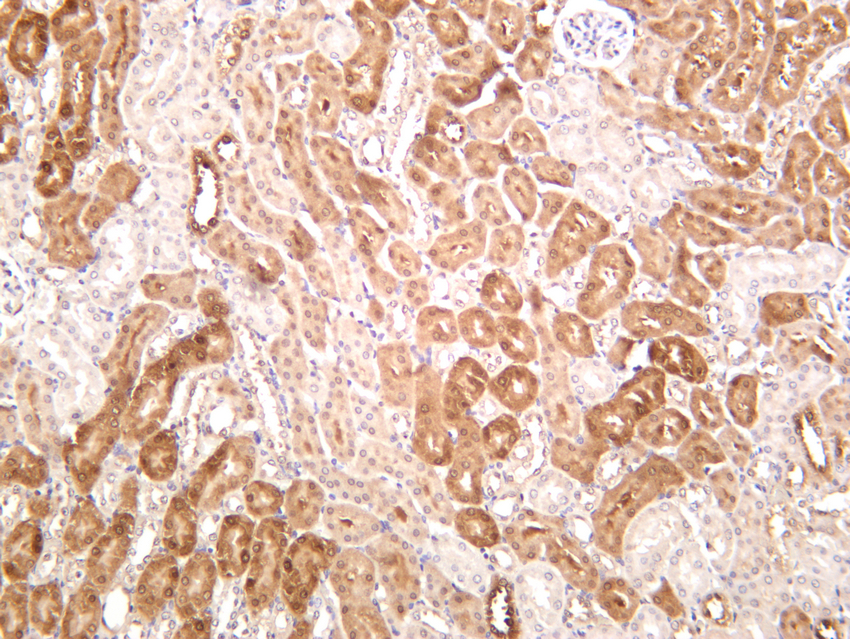NQO1 (PT0071R) PT® Rabbit mAb
- Catalog No.:YM8039
- Applications:WB;IHC;IF;IP;ELISA
- Reactivity:Human; Mouse; Rat;
- Gene Name:
- >>Ubiquinone and other terpenoid-quinone biosynthesis;>>Metabolic pathways;>>Biosynthesis of cofactors;>>Pathways in cancer;>>Chemical carcinogenesis - reactive oxygen species;>>Hepatocellular carcinoma;>>Fluid shear stress and atherosclerosis
- Protein Name:
- NQO1
- Sequence:
- NAD(P)H dehydrogenase [quinone] 1
- Human Gene Id:
- 1728
- Human Swiss Prot No:
- P15559
- Mouse Swiss Prot No:
- Q64669
- Specificity:
- endogenous
- Formulation:
- PBS, 50% glycerol, 0.05% Proclin 300, 0.05%BSA
- Source:
- Monoclonal, rabbit, IgG, Kappa
- Dilution:
- IHC 1:200-1:1000,WB 1:1000-1:5000,IF 1:200-1:1000,ELISA 1:5000-1:20000,IP 1:50-1:200,
- Purification:
- Protein A
- Storage Stability:
- -15°C to -25°C/1 year(Do not lower than -25°C)
- Other Name:
- NQO1;DIA4;NMOR1;NAD(P)H dehydrogenase [quinone] 1;Azoreductase;DT-diaphorase;DTD;Menadione reductase;NAD(P)H:quinone oxidoreductase 1;Phylloquinone reductase;Quinone reductase 1;QR1
- Molecular Weight(Da):
- 31kD
- Observed Band(KD):
- 31kD
- Background:
- This gene is a member of the NAD(P)H dehydrogenase (quinone) family and encodes a cytoplasmic 2-electron reductase. This FAD-binding protein forms homodimers and reduces quinones to hydroquinones. This protein's enzymatic activity prevents the one electron reduction of quinones that results in the production of radical species. Mutations in this gene have been associated with tardive dyskinesia (TD), an increased risk of hematotoxicity after exposure to benzene, and susceptibility to various forms of cancer. Altered expression of this protein has been seen in many tumors and is also associated with Alzheimer's disease (AD). Alternate transcriptional splice variants, encoding different isoforms, have been characterized. [provided by RefSeq, Jul 2008],
- Function:
- catalytic activity:NAD(P)H + a quinone = NAD(P)(+) + a hydroquinone.,cofactor:FAD.,enzyme regulation:Inhibited by dicoumarol.,function:The enzyme apparently serves as a quinone reductase in connection with conjugation reactions of hydroquinons involved in detoxification pathways as well as in biosynthetic processes such as the vitamin K-dependent gamma-carboxylation of glutamate residues in prothrombin synthesis.,induction:By dioxin.,mass spectrometry: PubMed:11735396,miscellaneous:Quinone reductase accepts electrons from both NADH and NADPH with equal efficiency.,polymorphism:The Ser-187 polymorphism may be linked to susceptibility to forms of cancers.,similarity:Belongs to the NAD(P)H dehydrogenase (quinone) family.,subunit:Homodimer.,
- Subcellular Location:
- Cytoplasm
- Expression:
- Colon,Liver,Pooled,
Chemopreventive effects of atractylenolide II on mammary tumorigenesis via activating Nrf2-ARE pathway. Oncotarget Oncotarget. 2017 Sep 29; 8(44): 77500–77514 WB Rat mammary tissues
Continuous activation of Nrf2 and its target antioxidant enzymes leads to arsenite-induced malignant transformation of human bronchial epithelial cells. TOXICOLOGY AND APPLIED PHARMACOLOGY Toxicol Appl Pharm. 2015 Dec;289:231 WB Human HBE cell
Curcumin protects against methylmercury-induced cytotoxicity in primary rat astrocytes by activating the Nrf2/ARE pathway independently of PKCδ. TOXICOLOGY Toxicology. 2019 Sep;425:152248 WB Rat astrocytes
Zhang, Hong, et al. "Therapeutic potential of bixin in PM2. 5 particles-induced lung injury in an Nrf2-dependent manner." Free Radical Biology and Medicine 126 (2018): 166-176.
Berberine hydrochloride alleviates imatinib mesylate – induced cardiotoxicity through the inhibition of Nrf2-dependent ferroptosis Food & Function Jie Zhang IF,WB Rat H9c2 cells
lncRNA HOTAIR promotes ROS generation and NLRP3 inflammasome activation by inhibiting Nrf2 in diabetic retinopathy. MEDICINE Wenjun Gou WB Human 1:1000 Human retinal endothelial cells (HRECs)
Sunitinib induces cardiotoxicity through modulating oxidative stress and Nrf2-dependent ferroptosis in vitro and in vivo CHEMICO-BIOLOGICAL INTERACTIONS Dongjie Li WB Mouse,Rat heart tissue H9c2 cell
- June 19-2018
- WESTERN IMMUNOBLOTTING PROTOCOL
- June 19-2018
- IMMUNOHISTOCHEMISTRY-PARAFFIN PROTOCOL
- June 19-2018
- IMMUNOFLUORESCENCE PROTOCOL
- September 08-2020
- FLOW-CYTOMEYRT-PROTOCOL
- May 20-2022
- Cell-Based ELISA│解您多样本WB检测之困扰
- July 13-2018
- CELL-BASED-ELISA-PROTOCOL-FOR-ACETYL-PROTEIN
- July 13-2018
- CELL-BASED-ELISA-PROTOCOL-FOR-PHOSPHO-PROTEIN
- July 13-2018
- Antibody-FAQs
- Products Images

- Rat kidney was stained with anti-NQO1 (PT0071R) rabbit antibody

- Various whole cell lysates were separated by 4-20% SDS-PAGE, and the membrane was blotted with anti-NQO1 (PT0071R) antibody. The HRP-conjugated Goat anti-Rabbit IgG(H + L) antibody was used to detect the antibody. Lane 1: Hela Lane 2: NIH-3T3 Lane 3: Rat kidney Lane 4: HepG2 Predicted band size: 31kDa Observed band size: 31kDa

- Human kidney was stained with anti-NQO1 (PT0071R) rabbit antibody

- Mouse kidney was stained with anti-NQO1 (PT0071R) rabbit antibody



